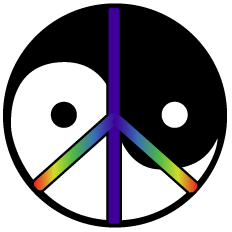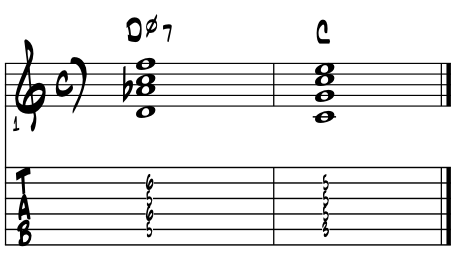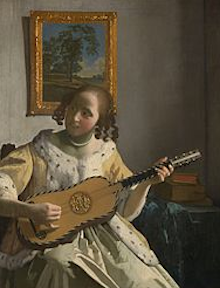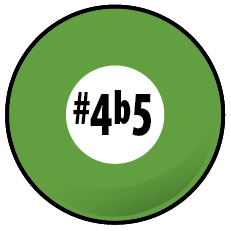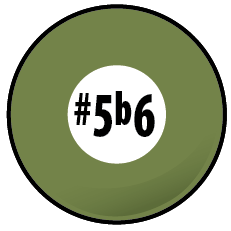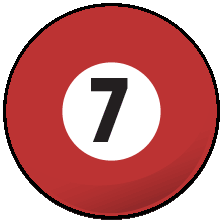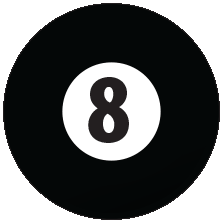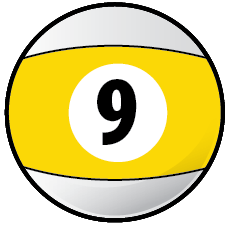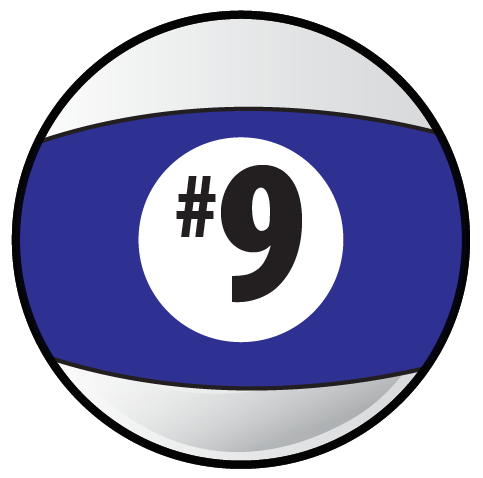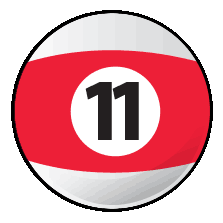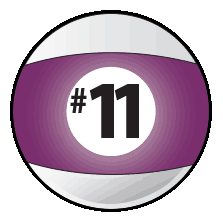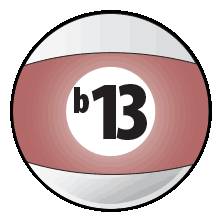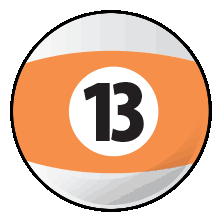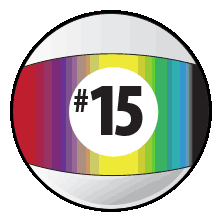~ diatonic or blue color tones ~ ~ an impressionism of the triad harmonies ~ |
|||||||||||||||||||||||||||||||
Nutshell / colortones. Ever search for the 'lost' chord ... or new chord vamps for your jams ? 'Jazz up' or 'bluesify' the chord changes in your songs ? There's five color tone numbers above the '1 3 5' of a triad so; '7, 9, 11, 13 (6) and 15', and each with their 1/2 step alterations, we then have 11 unique color tones which can be added to each of our four triads in almost any combination necessary (discovered) to create the perfect chord for that spot in our songs. Pianos love to do this and often have a sustain pedal to hold out the notes and help the process along. |
|
Each of individual colortones can have its own musical style to hang with. Folk, country love the added 6th (13). The blues chords loves a blue 7th tone to help capture the mood. Pop often goes with a major 7th, bring the love. Funk loves V 9', especially on a guitar which features one chord shape capable of many variations and rhythm syncopations for motoring up dance music. Jazz style chords can employ each of the 11 colortones and in many combinations, for jazz songs often have lots of chords and modulations, the colortone pitches help to nuance the motion between one chord and another, through key changes as well as providing variety, with V7 / dominant harmony usually most colorful. |
Colortones and voice leading. Colortone pitches can play a major role in voice leading; how we move from one chord to another. There's also passing tones between chords, often a colortone pitch, that'll both smooth things out between the changes and super expand one's range of artistic expression. Voice leading / chord progressions studies in this e-book range from Bach through Coltrane, so pure classical to pure jazz and all in between too with a focus on the blues; to understand the sounds of the music we each love dearest; and just how does this artist move between various 'C' chords to a various 'G' chords. |
For vocalists. As our chords are supportive of our melodies, they can reflect the pitches and stylistic character of a melodic line. Our core gospel pitches and its suspensions, are a clear way into the 'pull' of long held vocal notes over full bass and chords. Blue note 'filigree' in between the legato chord tones ... all by ear :) Once ya got 'em you'll know them forever, as blue notes tend to stick around in our hearts. The bluesy and often melismatic character of an R&B vocalist's ideas can be supported by a triad with an added 'blue 7th', 9th or 13th, as all of these are both solid color tones yet suspensions to triad chord tones defined / measured from its bass note. Suspensions with the melody notes over chords in gospel and rhythm and blues notes makes for hair raising fun so sure nice to bring when needed. |
Styles. The color tone pitches are so named as they 'color up' any type of triad. Often also theory termed as 'extensions' or simply 'tensions', the color tones are the pitches we add to triads that create the different chordal colors of our different styles of music. Children's songs and folk music are mostly created with the three notes of the triads. Blues influenced music loves and needs the blue 7th added to most if not all chords, in a blues styled song. Country music loves the major 6th and as with near all styles, V7 for its cadential motions. Rock mostly hangs with power chord triads, and the reduced to just 5th's of today's metalists, its blues influence often also looks for the blue 7th for chords. Pop music of today finds us mostly back to the triads, yet like jazz players, are often looking to the major 7th and major 9th and beyond, to color harmonies on tonic / One and Two type chords and often too into the upper reaches for V7 colors. Jazz stylings, and really from any historical era, all 12 pitches are in play and any single, or in combinations, included with any chord on any of the diatonic scale degrees, or the spots in between, creating the whole Bebop tamale. |
Colortone rule of thumb. To numerically identify colortones by numbers hinges on mostly two things; where the tone lives in the arpeggio and which other colortones are included. For example, if we want to call something a '9' in a chord and not '2', we probably should have a 7th underneath it in the arpeggio. If the 6th is moved up an octave in the voicing, it is probably a 13th now. And does a 13th always have to have an 11th underneath? Nope, but it can and a '13th' chord will near always have some sort of 7th, or 9th, in its voicing. |
Remember here, if we're not piano players, then we can't just push a pedal to sustain and then add in any number of pitches to our chords. For guitar, our voicings often leave out unnecessary or unwieldy pitches. So just be flexible and roll with it all. For as a theorist, you know the theory and have ways to 'sus out' and identify any colortone in any chord. Just be diplomatic and get the sounds you want, whatever anyone might want to call them :) There's plenty of chord shapes to cover all the color tones in various ways. Know that we've had may guitar voicings for a couple of hundred years now. |
Numbers of pitches / style. Starting back at our core philosophy, that the actual number of pitches in a chord; the three notes of the triad plus added color tones, will often help determine where it's commonly found in our musics. As artists here, we simply look to examine the available resources to understand their organic origins, a basis for conjuring up new colors to express our ideas. As theorists, we look to understand how we diatonically generate additional pitches above the triads that we term color tones. Thus empowered, we've the knowledge basis to mix and match, and alter, whatever comes along. |
The upper colortones; 9, 11 and 13, are surely creating chords that lean us towards any style with a blues hue and jazz direction. For most of our most popular styles today are major / minor triad based. Folk, country, pop and hip hop, while each will have its own character colortones, are diatonically created and triad based. |
Adding a 7th. That said, adding the 7th to any diatonic triad is really not all that uncommon today, in any style really. And this simple addition often adds that extra bit of artistry that opens up new harmony areas that can influence how the vocals sit atop. Vocalists of all stripes might also explore a guitar's open tunings, where oftentimes the pitch they're seeking for the vocal is not as easy to find in the supporting harmony. This creates some wiggle for a voice's intonations / expressiveness. Here's the 'UYM / EMG' chord spelling coffee chart', that cores much of the chord theory of this work, adding the diatonic 7th of each of our seven triads. Thinking in the key of 'C' major. Example 1. |
scale # degrees |
1 |
2 |
3 |
4 |
5 |
6 |
7 |
8 |
C major scale |
C |
D |
E |
F |
G |
A |
B |
C |
arpeggio # degrees |
1 |
3 |
5 |
7 |
9 |
11 |
13 |
15 |
C major arpeggio |
C |
E |
G |
B |
D |
F |
A |
C |
chord # / quality |
Imaj7 |
ii-7 |
iii-7 |
IVmaj7 |
V7 |
vi-7 |
vii-7b5 |
VIII |
diatonic 7th chords |
CEGB |
DFAC |
EGBD |
FACE |
GBDF |
ACEG |
BDFA |
CEGB |
Cool? Three note triads add their 7th. Any '1 3 5' triad now becomes '1 3 5 7' chord. By understanding how this chart works, and being able to sub in the letters of any of our key 12 key centers, covers most of spelling any chord in any key. Add in knowledge of chord inversions, finding new solutions for chord progressions should keep us busy. Then we need to make our music out of it, but that's the fun part as we've many songs to play and interpret our own ways. Oh, and is this the same chart for spelling the 7th chords for the natural minor key center ? Sure is, we just reshuffle the letters of the relative keys of 'C' major into 'A' natural minor. Ex. 1a. |
scale # degrees |
1 |
2 |
3 |
4 |
5 |
6 |
7 |
8 |
A minor scale |
A |
B |
C |
D |
E |
F |
G |
A |
arpeggio # degrees |
1 |
3 |
5 |
7 |
9 |
11 |
13 |
15 |
A minor arpeggio |
A |
C |
E |
G |
B |
D |
F |
A |
chord # / quality |
i-7 |
vii-7b5 |
III |
iv-7 |
v-7 |
VImaj7 |
VII7 |
i-7 |
diatonic 7th chords |
ACEG |
BDFA |
CEGB |
DFAC |
EGBD |
FACE |
GBDF |
ACEG |
Major key diatonic color tones named by number. Like most of our understanding of the theory, starting with a purely diatonic basis feeds the bulldog correctly each time. Once internalized, there's really no end to the machinations or slang wording to identify the pitches. Our triads each have their favorite color tones based on the way we most often find them in the musics we each dig. As for their theory, it is for the most part set in stone; we simply assign them a numerical designation as to their point within a chord's parent scale / arpeggio. We include these numbers along with a letter name pitch for the root of the chord, as when we're talking about a chord or in a chord symbol as designated in written music. Here in UYM / EMG we call this sort of thinking of music and math 'by the numbers.' So along these lines examine the diatonic scale, here built on the root pitch C, and its re-spelling by major and minor 3rd's into its arpeggio, both now identified by their numerical representations. Example 2. |
scale # degrees |
1 |
2 |
3 |
4 |
5 |
6 |
7 |
8 |
C major scale |
C |
D |
E |
F |
G |
A |
B |
C |
arpeggio # degrees |
1 |
3 |
5 |
7 |
9 |
11 |
13 |
15 |
C major arpeggio |
C |
E |
G |
B |
D |
F |
A |
C |
Cool so far? For building chords in our tertian harmony, we stack up various 3rd's to make our chords. And while any combination of pitches is possible, diatonic theory is the initial basis of understanding the colortones, keeping it all fairly straight. So by simply applying the numbers to the letter names of the arpeggio, the following color tone designations evolve. From the root pitch 'C.' Example 2a. |
arpeggio # degrees |
1 |
3 |
5 |
7 |
9 |
11 |
13 |
15 |
C major arpeggio |
C |
E |
G |
B |
D |
F |
A |
C |
color tones |
||||||||
C |
'C' is One, the root of the triad, so not a color tone |
|||||||
E |
'E' is Three, the major 3rd of the triad, so not a color tone |
|||||||
G |
'G' is Five, the 5th of the triad, so not a color tone |
|||||||
B |
'B' is Seven, the 7th above the root, thus a colortone |
|||||||
D |
'D' is Nine, an octave + maj 2nd above root, thus a color tone |
|||||||
F |
'F' is Eleven, an octave + per. 4th above root, thus a color tone |
|||||||
A |
'A' is Thirteen, an octave + maj 6th above root, thus a color tone |
|||||||
C |
'C' is One, two octaves above root, so not a color tone |
|||||||
Note capitol letters of the written number? Cool. In this UYM / EMG work, a number, spelled out in letters starting with a capitol letter, 'One', will always denote its interval relation to its root pitch. Is this why most of the discussions are in 'C' major? Exactly. No sharps, no flats, always thinking from the root. Always ? Well ... :) Here are these pitches from the above chart. Example 2b. |
 |
And for minor? Same basic ideas and numbering system but all shaded to create the natural minor colors. From the root pitch 'A', the following theory evolves. Ex. 2c. |
arpeggio # degrees |
1 |
3 |
5 |
7 |
9 |
11 |
13 |
15 |
A minor arpeggio |
A |
C |
E |
G |
B |
D |
F |
A |
color tones |
||||||||
A |
'A' is One, the root of the triad, so not a color tone |
|||||||
C |
'C' is the minor 3rd of the triad, not a color tone |
|||||||
E |
'E' is Five, the 5th of the triad, so not a color tone |
|||||||
G |
'G' is Seven, a minor 7th above the root, thus a colortone |
|||||||
B |
'B' is Nine, an octave + maj 2nd above root, a color tone |
|||||||
D |
'D' is Eleven, an octave + per. 4th above root, a color tone |
|||||||
F |
'F' is Thirteen, an octave + min 6th above root, a color tone |
|||||||
A |
'A' is One, two octaves above root, so not a color tone |
|||||||
Here are the diatonic color tone pitches of the natural minor tonality. From the root pitch 'A.' Example 2d. |
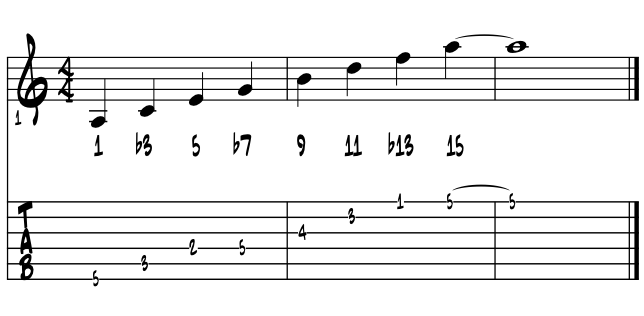 |
Common chord symbols. Well, here's a best guess as to what we often see in the written charts you're using. A universal basic rule of thumb here is, if you just get a letter name such as 'C' for a chord symbol, think of it as a three note triad that's major. And from this basis, just be flexible and sort it out as best as you can by ear. For there's a variance of symbols in the biz and we all make boo boo's in interpreting symbols. That's why many pro leaning cats have a pencil handy when working over their written music, making notes to clarify the symbols to reflect how they understand the music. Here's a basic start point of chord symbols found in the many real books out there on the market today. Example 3. |
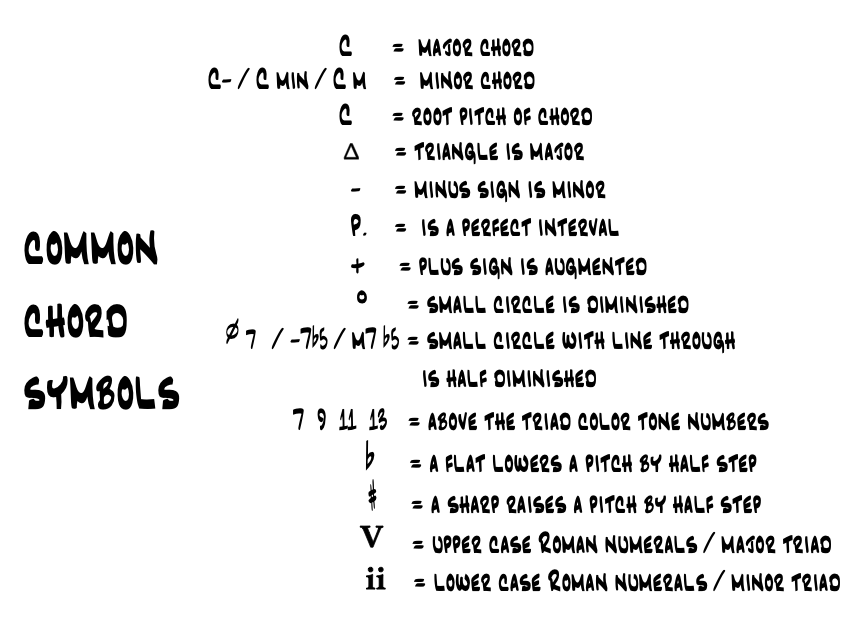 |
"You could be wrong a million times. You only have to be right once." |
wiki ~ Les Paul |
Color tone theory. Once we've our triads in place, the stage is set to add some extra coloring to our chords. Termed in this work as the colortones, and also known as tensions or upper structure tensions in other theory systems of thought, we simply select additional pitches to add to the triads. Which pitches we add is usually determined by style. |
Advancing artists might also consider viewing color tones in regards to a chord's 'type.' In this approach, a chord's function within the song and its bass line story and chord progression helps to determine the color tones added to the triads. In thinking diatonically, songs in a major key follow along the above charting of the pitches, while in a minor key, we've the pitch variations of the harmonic and melodic minor to consider and include as possible color tones as well. |
All of our 12 pitches are available on any of the chords. Some just sound better than others depending on one's tastes and thus have found their own enduring place within our Americana musical styles. The following discussions are general ideas along these lines, that style and historical precedence help to initially locate the popular color tones on each of the seven diatonic triads. |
Diatonic or altered colortones. So as with near all of our topics of music to understand, we can designate the pitches involved as being diatonic or not. Those color tone pitches that are not diatonic to a key center, we often term as 'altered.' For we've changed their pitch or borrowed them from another key center to jazz up our group of pitches. In chart form and pitch letter names, compare our diatonic 7 and altered / borrowed 5. Example 4. |
scale # degrees |
1 |
. |
2 |
. |
3 |
4 |
. |
5 |
. |
6 |
. |
7 |
8 |
C major scale |
C |
. |
D |
. |
E |
F |
. |
G |
. |
A |
. |
B |
C |
diatonic |
C |
. |
D |
. |
E |
F |
. |
G |
. |
A |
. |
B |
C |
altered as #'s |
. |
C# |
. |
D# |
. |
. |
F# |
. |
G# |
. |
A# |
. |
. |
altered as flats |
. |
Db |
. |
Eb |
. |
. |
Gb |
. |
Ab |
. |
Bb |
. |
. |
So with 12 total pitches and a couple of ways of lettering / notating our pitches the distinction emerges; that in relation to a chosen or created key center, any one pitch is said to be either diatonic or not. And with color tones, the non diatonic pitches are often termed 'altered.' Altered from their diatonic note? Yep. And they look an awful like the 'blue notes' for 'C' major ... yes they are. |
Minor key colortones. Into the bonus we go for with our natural minor group of pitches, we can easily jazz it up with it's close cousins, the harmonic and melodic minor groups of pitches. When we combine the pitches of the three variations together we end up with nine of our 12 total available. In writing and performing music, chords that back melodies written in a minor key often take a pitch or two extra from these two groups. Our goal here is simply to be able to locate a source for each pitch as it comes along in the music. Like ... 'wow that was cool ... wonder what that was ? Examine the pitches of the three minor groups, thinking from the root pitch 'A.' Example 5. |
scale # degrees |
1 |
. |
2 |
3 |
. |
4 |
. |
5 |
b6 |
6 |
b7 |
7 |
8 |
A minor scale |
A |
. |
B |
C |
. |
D |
. |
E |
F |
. |
G |
. |
A |
A harmonic minor |
A |
. |
B |
C |
. |
D |
. |
E |
F |
. |
. |
G# |
A |
A melodic minor |
A |
. |
B |
C |
. |
D |
. |
E |
. |
F# |
. |
G# |
A |
combined pitches |
A |
. |
B |
C |
. |
D |
. |
E |
F |
F# |
G |
G# |
A |
Wow, that's chromatic at the end of the line. All by half steps from 'E' to 'A', chromatic, to close the loop. So clearly we can see that there will be a couple of choices for the colortones of the 6th and its upper octave 13 and the 7th; both blue and major 7th's are included. So when we build up chords we've a few more options than just the diatonic seven. Here's the arpeggio / partial chord spelling chart for the combined pitches from just above. Example 5a. |
scale # degrees |
1 |
b2 |
2 |
b3 |
3 |
4 |
b5 |
5 |
b6 |
6 |
b7 |
7 |
8 |
A minor / 9 pitch scale |
A |
. |
B |
C |
. |
D |
. |
E |
F |
F# |
G |
G# |
A |
arpeggio # degrees |
1 |
b3 |
5 |
b7 |
7 |
9 |
11 |
b13 |
13 |
15 |
. |
. |
. |
A minor 9 pitch arpeggio |
A |
C |
E |
G |
G# |
B |
D |
F |
F# |
A |
. |
. |
. |
And awfully close to 'A' major. With these added pitches and subtracting some others, we're just the one essential pitch away from the major scale grouping of pitches. Of course, the one we're missing is the one that counts the most when making things minor :) Ex. 5b. |
scale # degrees |
1 |
2 |
3 |
4 |
5 |
6 |
7 |
8 |
A melodic minor scale |
A |
B |
C |
D |
E |
F# |
G# |
A |
A major scale |
A |
B |
C# |
D |
E |
F# |
G# |
A |
So as we evolve our natural minor group with the addition of the pitches from harmonic and melodic minor groups, are we just trending towards the major scale? Absolutely. Even without getting completely to major, our raised 6th and 7th degrees create some new pathways both in melody and in generating harmony to support the lines. The leading tone 'G#' is essential to make the Five chord a major triad, which with an added blue / dominant / b7, creates the essential two pitch tritone tension of the V7 dominant chord. |
Having just the raised 6th 'F#' in the group leans us to the key center of 'G' major, thus potentially adding in all that is available there. With 'F#', the mode from our root pitch 'A' becomes Dorian, and Five (D7), is a major triad with b7, thus our Two / Five evolves from within these pitch additions. It really is pretty twisty theory at this level, so we think from the root pitch, start diatonically so hopefully, we'll find our way forward and back too, if it becomes necessary to take a step back to then gain two steps going forward :) |
Color tones of the seven diatonic triads. Easiest way here just might be to go through each one of the seven diatonic notes of the relative major / minor scale and see just what color tones commonly shake out and what styles we'll commonly find them. While it seems that there are a lot of variables here, and there can be, that certain colors consistently find their way into a musical style and help create a certain character of a style is gospel. Like blue jeans being blue? Yep :) In academia, we're simply 'big picture' looking at all this theory, here with an eye towards understanding the color tones and where we might use a few new ones in the music we are creating today. |
One. In a song in a major key, the triad built on One is a major triad and all of the diatonic colortones are generally in play. Please examine the letter pitches, followed by tonic / One chord voicings / color tones. Keep in mind that the One chord is also designated in this text as a chord type. So its structure becomes a template for aural and tonal stability. Please examine the letters and colors from the root pitch 'C.' Example 6. |
scale # degrees |
1 |
2 |
3 |
4 |
5 |
6 |
7 |
8 |
C major scale |
C |
D |
E |
F |
G |
A |
B |
C |
arpeggio # degrees |
1 |
3 |
5 |
7 |
9 |
11 |
13 |
15 |
C major arpeggio |
C |
E |
G |
B |
D |
F |
A |
C |
 |
Cool? Easy really as anything beyond the major 7th becomes a bit of pop but mostly leaning jazz. Notice how the 11th is raised by half step in the third bar to the non-diatonic #11? The 'C'11 chord is probably more of a 'sus' chord as there is no 3rd in the triad. So not really a solid, tonic function chord. With '11' raised up by half step we avoid the 'E' to 'F' / b9th interval pairing and with "#11 / F#', create V of V and some nice bi-tonal sounds, character of the jazz modernes. |
Tonic major 7th colortone in folk rock into pop and beyond. The Grateful Dead's own "Eyes Of The World" features the major 7th color as the opening chord, setting the mood for their essential story that follows. In a pop leaning gem, Stevie Wonder's "My Cherie Amour" is \he major 9th colortone on One is a bossa nova staple, for the most part a must have. The voicing in the above idea is a bossa keeper in that we guitarists get to alternate the One / Five / One essential bass motions of the bossa style with a rather handy, right under our fingers chord solution. Read on ! |
|
Bossa staple color. The major 9th colortone on One is a bossa nova staple, for the most part a must have. The voicing in the above idea is a bossa keeper in that we guitarists get to alternate the One / Five / One essential bass motions of the bossa style with a rather handy, right under our fingers chord solution. Example 6a. |
|
 |
There's a few of these alternating bass, bossa nova shapes for guitar. Do 'bossify' the rhythms as you see fit. And no blues chords on One? Diatonically there can't be really, for the blues music is based on the dominant, V7, harmony. The chord with the two pitch tritone? Exactly. We'll surely see it right soon below when we get to Five. That's one of the tricky theory 'rubs' with the blues. No worries if we source things diatonically and always try to think from the root of the chord or chords in play. |
Two. In a song in a major key, the triad built on Two is a minor triad and its diatonic colortones are all in play. Measuring these intervals from the root; its 7th is a minor or blue 7th, 9th is a major 9th, 11 is a perfect 4th up an octave, and 13th is a major 6th up an octave. Along with One and Five, Two is also designated as a chord type. We can find any of these chord colors in most of our styles excepting songs for kids and folk songs, whose chords are mostly limited to the three note triads with an added 7th on Five chord. Please examine the diatonic color tone pitches built on Two. Example 7. |
scale # degrees |
1 |
2 |
3 |
4 |
5 |
6 |
7 |
8 |
C major scale |
C |
D |
E |
F |
G |
A |
B |
C |
arpeggio # degrees |
1 |
3 |
5 |
7 |
9 |
11 |
13 |
15 |
Two / D minor arpeggio |
D |
F |
A |
C |
E |
G |
B |
D |
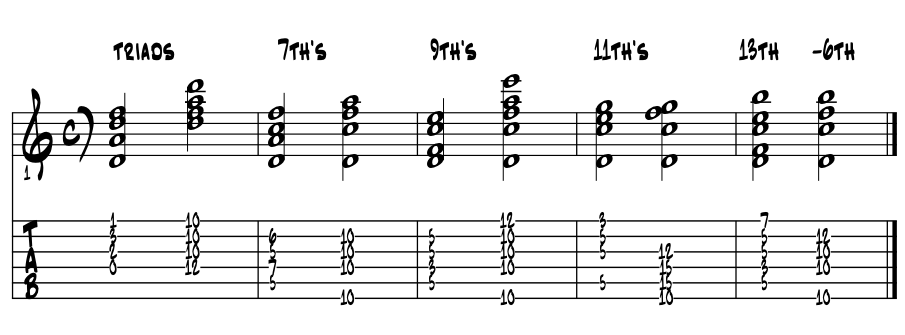 |
Some interesting colors yes? And with five or so unique minor scale constructions, plus their modes, we've additional options to pursue. Diatonic Two is also a chord 'type', and as such becomes a bus stop for all minor chords and a ton of theory. As the harmonic motion to Four is so predominant in our musics, when we evolve Four into Two, to create a Two / Five motion to Four, things can change in a hurry. |
Too common a color to leave out. A very common coloring of Two comes from its diatonic role as Two in the minor tonality. Known as a 'minor 7th / flat 5', this chord is also the diatonic Seven 7th chord of any major key. So why here as part of Two? Well in the literature, we'll find this half diminished coolness on Two and even Three for that matter, in both songs written in major or minor key centers. It adds a bit of a surprise spice to major while a true diatonic, tonal gravity color of the minor key. Amazing how that works huh? Is this just part of the 'relatives' nature of the same group of pitches creating both major and minor key centers / tonalities? Yep, exactly. Examine the color tone pitches of Two, now noting the altered 5th. Example 7a. |
scale # degrees |
1 |
2 |
3 |
4 |
5 |
6 |
7 |
8 |
C major scale |
C |
D |
E |
F |
G |
A |
B |
C |
arpeggio # degrees |
1 |
3 |
5 |
7 |
9 |
11 |
13 |
15 |
Two / D minor arpeggio |
D |
F |
Ab |
C |
E |
G |
B |
D |
Wow ... somebody say 'amen.' So be it ! Sound like we've come to a resting point in the music? Breath a sigh of relief ? That's the idea :) Tension to resolution, or not, as the artistic case might be. Remember that this Two half diminished 7th is also the diatonic chord built on Seven in a major key. The half diminished 7th is just too common as Two in both major and minor jazz compositions not to mention here. |
Not that uncommon to leave out. A second not uncommon colortone for jazzing up the diatonic minor triad on Two is to use the major 7th atop the triad. We hear it throughout the styles, and while mostly as a passing chord between tonic and b7, don't be surprised to find it as a stand alone chordal color, finding a bit of an exotic spot in the musics. Here's a lovely 'passing 7th' motion, built on Two of 'C' major. Example 7b. |
scale # degrees |
1 |
2 |
3 |
4 |
5 |
6 |
7 |
8 |
C major scale |
C |
D |
E |
F |
G |
A |
B |
C |
arpeggio # degrees |
1 |
3 |
5 |
7 |
9 |
11 |
13 |
15 |
Two / D minor arpeggio |
D |
F |
A |
C# |
E |
G |
B |
D |
Sound familiar? Fairly common of slower tempo songs in a minor key. Easily added in the right spots as determined by the artist, you :) |
Three. In a song in a major key, the triad built on Three is a minor triad, root note of the Phrygian mode and most of the diatonic color tones work just fine. We do have a bit of a rub with its 9th, as it creates the minor 9th or b9 interval from the root. Also 13, which is our tonic pitch, often leans the chord towards sounding as a first inversion collection of these pitches. The seventh on Three is cool and in all probability the most popular of its colortones, all in and throughout our styles. Eleven is also common, creating a bit of a suspended or floating quality to the chord. Common as a natural, stepwise passing chord between Two and Four, the triad on Three is not uncommon in folk, blues, rock and country styles, and even becomes the first chord of a song's verse on occasion. Please examine the letter names of Three, as created within the key center of 'C' major. Example 8. |
scale # degrees |
1 |
2 |
3 |
4 |
5 |
6 |
7 |
8 |
C major scale |
C |
D |
E |
F |
G |
A |
B |
C |
arpeggio # degrees |
1 |
3 |
5 |
7 |
9 |
11 |
13 |
15 |
Three / E minor arpeggio |
E |
G |
B |
D |
F |
A |
C |
E |
Here's the potential 'rub' between our root pitch 'E' and its diatonic 9th and 13th. Example 8a. |
 |
Here are some of the common colortones and chord shapes built on Three, thinking 'C' major. Example 8b. |
 |
See any you know? Without a 9th or 13th it gets pretty thin. As 'E' is the major 3rd of our tonic triad, it gets additional work there in 1st inversion tonic chords. Also as a passing chord between One and Four, going either way is fairly common. Example 8c. |
 |
Cool? So just smoothing out the motion to Four? Maybe, but variety is also nice as is the case above with the 'lighter' tonic sound of 1st inversions. These inversion chords oftentimes come up in chord melody style playing and arrangements, when a song's storyline gets interpreted with what we often term 'block' harmonies. A style of orchestration for guitar where each of the notes in a melody gets supported by a chord. |
This block chord approach is often one pass through a song to clearly present the idea as the composer intended, followed by our 'theme and variations. The 3rd inversion Five chord, on beat three of the second measure two, is also a keeper. It's quite a swing thing and your bass player might appreciate it too as you stay off their root notes pitches that tell their story :) |
Four. The One and Four chords are nearly identical in structure, function and colorings. As One and Four function so alike, providing stability and resting points in our songs, the color tones for their chords are essentially the same. What works for One is cool for Four too. The one diatonic difference is with the 11th, a portal towards the whole tone color from within the diatonic realm. Please examine the letter name pitches building up Four out of the pitches of 'C' major. Ex. 9. |
scale # degrees |
1 |
2 |
3 |
4 |
5 |
6 |
7 |
8 |
C major scale |
C |
D |
E |
F |
G |
A |
B |
C |
arpeggio # degrees |
1 |
3 |
5 |
7 |
9 |
11 |
13 |
15 |
Four / F major arpeggio |
F |
A |
C |
E |
G |
B |
D |
F |
Looks like the pitches of 'F' Lydian ... ? Yep, sure is. So colortone wise just like our tonic, we've a major 7th, major 9th and the 13th, which is the major 6th interval moved up one full octave. The 11th is diatonically 'raised' by half step from the usual perfect 4th interval, thus termed augmented. Unique to Four, this raised 4th helps core and bring the Lydian mode color of the ancients to our pitches today. Here's some of our basic voicings for the colortones. Example 9a. |
 |
So much like the One chord yes? Same stability and sense of arrival. That near every Americana songs finds its way to Four tells us it's a keystone in composition. Any blues chords built on Four in major? Yea, tons but they're built just like the V7 chord. Which is next, but first, a super key discovery point to explore ... :) |
~ super theory game changer ~ |
Elevation of the 11th. Let's take a quick look and compare the interval steps of the One and Four chord diatonic arpeggios and look for the organics of the augmented 11th interval. Please examine the letter names and their arpeggiated tertian intervals. Ex. 10. |
arpeggio # degrees |
1 |
3 |
5 |
7 |
9 |
11 |
13 |
15 |
One arp. intervals |
. |
maj 3 |
min 3 |
maj 3 |
min 3 |
min 3 |
maj 3 |
min 3 |
One arpeggio pitches |
C |
E |
G |
B |
D |
F |
A |
C |
Four arp. intervals |
. |
maj 3 |
min 3 |
maj 3 |
min 3 |
maj 3 |
min 3 |
min 3 |
Four arpeggio pitches |
F |
A |
C |
E |
G |
B |
D |
F |
'C to F / F to B.' From the chart in bold we see the interval swap; minor to major from Nine to create the augmented 11th. And all of our pitches are still diatonic yes? Sure are, we're just illuminating where the #11 is naturally found in our relative major / minor scale grouping. Here's some of the positions for these pitches. Thinking from the root pitch 'F', within the key center of 'C' major. Example 10a. |
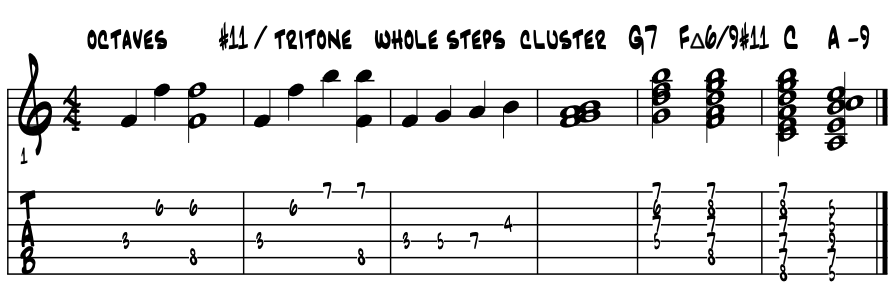 |
Hearing some of the augmented 11th and its 'whole tone' color through the line? Without this ever so subtle shift we'd just be building a major scale from 'F.' Please examine the letter name pitches. Example 10b. |
arpeggio # degrees |
1 |
3 |
5 |
7 |
9 |
11 |
13 |
15 |
One arp. intervals |
. |
maj 3 |
min 3 |
maj 3 |
min 3 |
min 3 |
maj 3 |
min 3 |
Four arpeggio pitches |
F |
A |
C |
E |
G |
Bb |
D |
F |
| The 'Bb', the natural 11th as measured from the root, is the one pitch that varies here to create the diatonic key center of 'F' major. Down an octave, the 11th becomes the 4th scale degree, the essential catalyst pitch for modulating around the cycle of 5th's. |
Quick review; colortones One and Four. So from the root pitch; our major 3rd, perfect 5th, major 7th, major 9th and major 13th color tones and intervals are all identical. Which colortone wise covers all of our styles including our finest Hollywood jazz chords. Just this slight shifting of the intervals between One and Four does diatonically build the #11 into Four's arpeggio and chord; so tonic like stability with whole tone upgrade. |
Lydian mode. While we're here, let's take a quick look at the Lydian mode. We swap arpeggio thirds for scaler half and whole step intervals and match pitches with interval steps. Thinking the pitches of the 'C' major scale from 'F' to 'F', examine the letter pitches and stepwise scale formula for the Lydian mode. Example 11. |
scale # degrees |
1 |
2 |
3 |
4 |
5 |
6 |
7 |
8 |
C major scale |
C |
D |
E |
F |
G |
A |
B |
C |
intervals |
. |
1 |
1 |
1 |
1/2 |
1 |
1 |
1/2 |
F Lydian |
F |
G |
A |
B |
C |
D |
E |
F |
So just like the major scale we have a leading tone 7th, half step below the tonic. We also see the 'F' to 'B' as 'three tones.' So a tritone ? Yep. Three whole steps or major 2nd intervals. So just as their chords and colortones, the Lydian and Ionian modes are near identical also. Lydian varies in that it brings out more of the whole tone / augmented color as a tonal center, so it brings a degree of tonal ambiguity within its tonic center. |
If we continue these three consecutive whole steps, we could continue the whole step (1) symmetry and create a whole tone scale. Example 11a. |
interval |
. |
1 |
1 |
1 |
1 |
1 |
1 |
F whole tone scale |
F |
G |
A |
B |
C# |
D# (Eb) |
F |
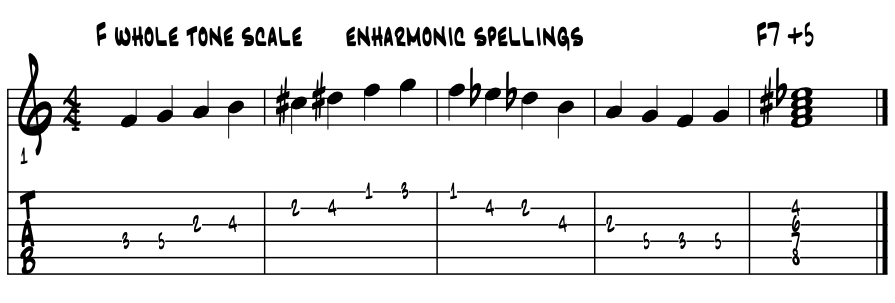 |
Why do this? Because we can ... :) And as theorists we simply may want to know the organic source of things. Never know when we might need that one chord or color to complete our artistic, compositional puzzle. So the wholetone scale is a perfectly closed loop? Sure is. And while we're in this neck of the woods ... |
Lydian b7 mode. A fairly common and colorful group, leaning whole tone-ish, is Lydian b7. This is a jazz color mostly, though it gets nicked and called upon on rare occasions in the any of the rock / blues sounds. Its organic theory can be derived and evolved this way. Examine the pitches and compare their sounds. Ex. 11b. |
scale # degrees |
1 |
2 |
3 |
4 |
5 |
6 |
7 |
8 |
C major scale |
C |
D |
E |
F |
G |
A |
B |
C |
F Lydian |
F |
G |
A |
B |
C |
D |
E |
F |
F Lydian b7 |
F |
G |
A |
B |
C |
D |
Eb |
F |
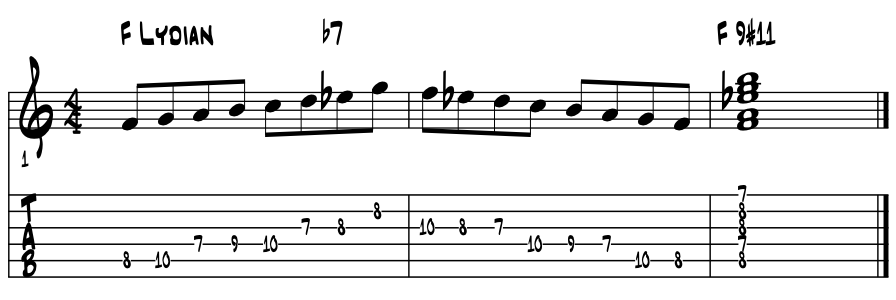 |
Where is it used? Well it'll create interesting melodies and can diatonically generate some interesting chords. Jazz improv is its main domain and it's a catalyst color to points beyond its initial diatonic, subdominant position as illuminated in this discussion of diatonic colortones. |
In looks and sounds. Cool and a bit out there yes? Whole tone colors have their own uniqueness for certain. And these pitches sound like 'C' melodic minor yes? They sure do and are the same. And here we find another improv portal to explore. Here are the above pitches, now from 'C' to 'C', so we're creating the 5th mode of a 'F' Lydian b7 group. Example 11c. |
 |
Just sifting through the pitches. A mode within a mode within a mode within a mode :) Here the close of the line in the melodic minor? Cool, that's the juice of the leading tone 7th working its magic. Thanks to the perfect closure of all of our resources, there's an endless looping of the colors within, thus the opening lick here of 'modes within modes within modes.' For in the gradual modal shifting of the pitches, that reshape their tonal gravity around one central pitch, (a tonic) their finer aural and emotional hues are revealed. Cool ? |
Advancing jazz improvisors will apply the Lydian / melodic minor colors to chord changes in a similar manner as the V7b9 chord substitution properties enable. In this book we call this the 'softening' of the diminished colors and use 'artistic license' to help glue it all together. Compare the pitches of the two groups; 'F' Lydian b7 and 'C' melodic minor. Example 5i. |
scale # degrees |
1 |
2 |
3 |
4 |
5 |
6 |
7 |
8 |
F Lydian b7 |
F |
G |
A |
B |
C |
D |
Eb |
F |
C melodic minor |
C |
D |
Eb |
F |
G |
A |
B |
C |
Same pitches / two start points. Thus different intervals between the pitches, which when balanced against a central tonic pitch, create various degree of gravity and predictability. |
No surprise that jazz players want to jazz it up, and with tempos, that usually can include to speed things up. Horn players, who by the nature of their instruments cannot play chords, rely on scales and arpeggios to make their melodies sound out the changes. And for some cats the faster the better. In this 'blur' of speedy notes the colors come forth. Along these lines, back in the 60's there was the original 'sheets of sounds' pioneered by Coltrane. And while not the first artist in this approach, he built the chops, had the fame and good luck to inspire this 'sheets of sound' description by a music reviewer. Thus forever after we've had a phrase to describe the 'exhausting of the possibilities', created through the chord substitution possibilities of V7b9 and the blues, added to Coltrane's accomplishments and compositional contributions to the evolution of our Americana musics. |
|
Five. The Five chord is the diatonic home of our tension creating 'Mixolydian motor' that decides how and where things generally go in the music we create. Known as the dominant, and one of our three designated chord types, the colortones available on Five within a major scale diatonic key center include ALL of the possibilities of ALL of the pitches ... except one. All except one? Yep. Which one? Any guesses? Hint; what makes a dominant chord a dominant chord? A two pitch tritone? Correct. And those pitches are ... ? |
Regardless, so once past the major triad of root, major 3rd and perfect 5th, the 7th, 9th, 11th and 13th are all available. And further, even the root, 3rd and 5th are available for alteration, often positioned up one octave or not as the case may be. |
And depending on our musical style, we'll often push past the diatonic boundaries of 9, 11, and 13 and incorporate their alterations into our dominant / Five chords. First, examine the letter names and sounds of the diatonic pitches and color tones built on our root pitch 'G', Five, thinking in 'C' major. Example 12. |
scale # degrees |
1 |
2 |
3 |
4 |
5 |
6 |
7 |
8 |
C major scale |
C |
D |
E |
F |
G |
A |
B |
C |
arpeggio # degrees |
1 |
3 |
5 |
7 |
9 |
11 |
13 |
15 |
Five / G major arpeggio |
G |
B |
D |
F |
A |
C |
E |
G |
 |
Cool? Vanilla basics here though we're up through the colortones of the whole diatonic arpeggio. |
And their alterations? Color tone alterations, and the myriad of different voicings they can create on the dominant Five chord are like totally legion; for real just just an endless number of possibilities. Add in chord inversions and substitutions ... and it is full game on for the creative artist. We talking jazz here? Yep pretty much, though blues too a bit. Please examine the letter pitches followed by some common chord shapes, all of which are movable chords. Example 12a. |
arpeggio # degrees |
1 |
3 |
5 |
7 |
9 |
11 |
13 |
Five / G major arpeggio |
G |
B |
D |
F |
A |
C |
E |
arpeggio # degrees |
. |
b5 |
#5 |
b9 |
#9 |
#11 |
b13 |
altered colortone pitches |
. |
Db |
D# |
Ab |
Bb |
C# |
Eb |
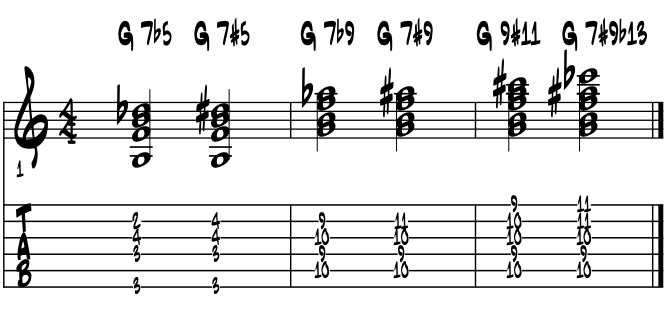 |
All of these chords, and altered colortones, are jazz and blues chords really. Surely The 'b5' is a jazz chord. The #5 often in a minor blues song and progression, b9 very common jazz chord, #9 again a blues chord, #11 is jazz as it leans polytonal and the b13 paired with #9 probably qualifies for Hollywood status as a dominant chord type. So in folk, rock, country and pop styles, these sorts of dominant colors are saved for when a big blues or jazzy effect is desired. That said, not at all unusual to hear these colortones throughout the libraries among Kings of Pop icons such as Stevie Wonder, 'Steely Dan' and anything Quincy Jones might have produced over the decades. Choose and follow links forward for further discovery learning with these dominant colortones. |
|
 |
The Six chord. As the Six chord is home of the relative minor, its parent scale is the natural minor / Aeolian grouping of pitches. We can follow along these pitches and create our diatonic colortones. Please examine the letter name pitches as we evolve the relative key centers of 'C' major becoming 'A' natural minor, followed by some fairly common minor triad based colortone chords and voicings. Example 13. |
scale # degrees |
1 |
2 |
3 |
4 |
5 |
6 |
7 |
8 |
C major scale |
C |
D |
E |
F |
G |
A |
B |
C |
scale # degrees |
1 |
2 |
3 |
4 |
5 |
6 |
7 |
8 |
A minor scale |
A |
B |
C |
D |
E |
F |
G |
A |
arpeggio # degrees |
1 |
3 |
5 |
7 |
9 |
11 |
13 |
15 |
Six / A minor arpeggio |
A |
C |
E |
G |
B |
D |
F |
A |
 |
Minor tonic / Two with a major 9th. While all of the diatonic color tones are cool over a minor triad, the diatonic 9th is one special color. Deep, dark, moody and full of love and passion, learn of it here if need be a weave it into one of your songs, or write one around it. Here's an evolution of sorts for the '9' colortone over the minor triad. Thinking 'A' minor here, mostly. Ex. 13a. |
scale # degrees |
1 |
2 |
3 |
4 |
5 |
6 |
7 |
8 |
A minor scale |
A |
B |
C |
D |
E |
F |
G |
A |
arpeggio # degrees |
1 |
3 |
5 |
7 |
9 |
11 |
13 |
15 |
A minor arpeggio |
A |
C |
E |
G |
B |
D |
F (#) |
A |
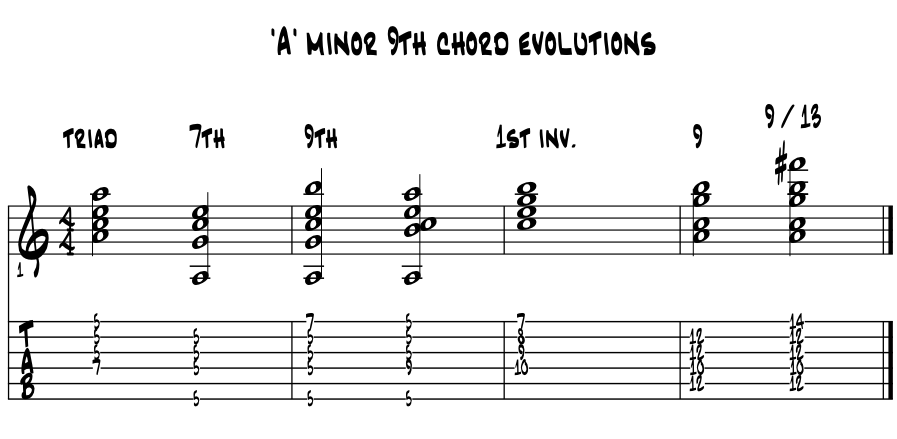 |
Go to colors? If these shapes and colors are new for U, they just might spark some musics that you've not really done before with minor chords. If so then yet another first ! If and when these become 'default' minor colors, chances are you're digging to 'jazz it up.' :) |
Three in one. As the natural minor group is easily evolved by altering its 6th and 7th degrees into the harmonic and melodic minor groupings, we open up some new opportunities for the color tones with these additional pitches. Examine the pitches. Example 13b. |
scale # degrees |
1 |
. |
2 |
3 |
. |
4 |
. |
5 |
. |
6 |
. |
7 |
8 |
A minor scale |
A |
. |
B |
C |
. |
D |
. |
E |
F |
. |
G |
. |
A |
A harmonic minor |
A |
. |
B |
C |
. |
D |
. |
E |
F |
. |
. |
G# |
A |
A melodic minor |
A |
. |
B |
C |
. |
D |
. |
E |
. |
F# |
. |
G# |
A |
nine combined pitches |
A |
. |
B |
C |
. |
D |
. |
E |
F |
F# |
G |
G# |
A |
Using just the raised 6th gives us the pitches of 'G' major and all that comes along with it. The raised 7th evolves the diatonic Five chord from a minor triad into major, setting the stage for all things colortone wise for V7. Examine the evolutions of the diatonic Four and Five chords of natural minor with added pitches. Ex. 13b. |
 |
Two / Five. Evolving the Two / Five ( A- / D7 ) motion in bar 2, through adding in the major 6th, is important as a sleeker, jazzier version of Four / Five / One. Thinking Two / Five is jazz leaning opens a wide spectrum of colors and substitutions for jazzing things up. |
Making the minor Five chord major and into a true V7 chord, is probably more common than its diatonic minor v, all through the literature and in all of the styles really. That said, anything that might be considered 'roots', could very well use the minor dominant. In some of the reggae styles, the minor Five is not uncommon in cadential motions. As theorists we just tend to want to know the theory of the evolutions. Example 13c. |
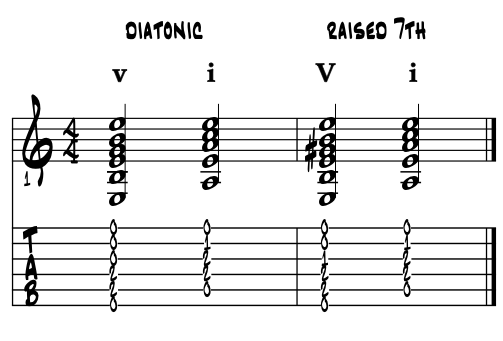 |
Quick review. Cool? Subtle difference? Click it again? Hear the leading tone 'G#' enhance the degree of closure to the 'A' minor triad? Keep clicking :) It's there :) This one bit of theory, altering the natural minor's diatonic b7 'G' into a leading tone, 'G#' / a major 7th, opens up all of V7's colortone and all of its substitutions. The stronger sense of finality in cadential motions has been popular in composing in the minor tonality for 500 years or so now. Learn about it here and now if need be :) |
The Seven chord. The Seven chord in the major tonality is home of the diminished triad. Surely one of a kind, two minor 3rd intervals stacked leaves little, if any, room for additional colors. We do add a 7th to the triad and in two forms, to build up what we term as the 'half and fully diminished 7th chords.' There's a common suspension of the pitches that happens with Seven, which we could consider a colortone of sorts, but beyond that there's very little else in the literature or any style really, that expands the harmony with colortones from Seven. Please examine the pitches as we evolve Seven from within the key center of 'C' major. Example 14. |
scale # degrees |
1 |
2 |
3 |
4 |
5 |
6 |
7 |
8 |
C major scale |
C |
D |
E |
F |
G |
A |
B |
C |
arpeggio # degrees |
1 |
3 |
5 |
7 |
9 |
11 |
13 |
15 |
Seven / B minor arpeggio |
B |
D |
F |
A |
C |
E |
G |
B |
B -7b5 |
B |
D |
F |
A |
. |
. |
. |
. |
So the diatonic 7th is cool, making the 'half diminished' 7th chord. The diatonic 9th 'C' makes for a minor 9th interval, so quite dissonant. The 11th, 'E', is the 'sus4' so, while not usually included in a chord it is used as a suspension. The 13th 'G' over the 'B' create more of a first inversion quality than colortone effect it seems. Hear the evolutions of the numerical theory. Ex. 14a. |
 |
Well, just not a lot of colortone choices but the one's we get are keepers. At least to jazz and pop players. The half diminished 7th voicing in the second bar is a common blues chord; B-7b5 is a G9 chord in first inversion, so 'B' in the bass. Common, cool and very unique in a rather handy chord shape. Surely there's more here for diatonic Seven, just explore :) And the fully diminished 7th? |
The common colortones of various musical styles. Colortones are mostly blues and jazz thing. So anywhere we've some blues hue or 'jazz it up' as they say, chances are we'll add in some color above the triads, both major and minor. Here's just a brief survey of what we may find where in the literature. |
Children's songs. The 6th on tonic and Four is not uncommon and a b7 on Five to V7 to push the cadence a bit more in major keys. On more modern arrangements sky's the limit, although diatonic generally rules the day. Sing-able, funny and joyous, and vanilla minor keys for a sad song. |
In a folk styling. In folk storytelling, three chords and the truth is often the rule of the day. And most times these chords are the diatonic triads. Any blues influence brings in the b7 colortone, while using an open tuning opens things further colortone possibilities. |
|
In a blues styling. The blues is most often dominant V7 based as its tonic chord. The blues version of the three chords and the truth in a 12 bar form. 9, #9 on V and 13 are common also. |
In 'jump' or rockabilly. The colortones of major 6th and b7 rule the day. Chord progressions generally run the 1, 4, and 5 through a 12 bar blues form. The Five chord is V7, 1 and 4 are often 6th / 13th jump chords with our without the blue note 7th. Here's a few common of the 'jump' shapes. Hip to the 'half step lead in?' Example 15. |
 |
In a country and rock styling. Country loves the 6th (ultimate jumper just above ) while rock is triads and blues the b7th added to every chord. When the pop influence comes along major 7th is not uncommon. Harder rock loves #9. |
In a pop styling. Everything is on the colortone table. Though mostly pure diatonic triad based and weaving of the 3 and 3, modulations, both within a song and at the close of an arrangement, i.e., up a step, are not that uncommon. Pop music loves hooks and hooks are usually very signable, memorable and unforgettable :) That jazz was America's pop music for 60 odd years, before rock and roll and forward, can tell us that any colortone can be anywhere. |
In a bossa styling. The bossa loves the major 7th and major 9th colortones on tonic chords. The softer color tones often disguising the incessant pulse of its dance. All of the colortones are in play really, as the gifted composers weave stories into puzzles of form, where each piece is shaped and colored to create the bossa mosaic of love motored on the Latin styled grooves. Here's a few tonic / One chord shapes that love the bossa rhythms. Example 15a. |
 |
In a jazz styling. All the above voicings and chords / colortones are jazz chords too of course :) For all of the colortones are available for sure, with periods within the 100 odd years of jazz now each having their faves as the art form evolves. The blues, early on, becomes the basis of the original Americana story. Then in the gay 90's, the complex poly melody weave of ragtime. More blues in the teens and 20's. Swing in the 30's with a big band choir of mostly diatonic, inside colorings of the harmony. Total dance music as America's pop music. Bebop of the 40's expands to include more dissonance of b5, b9 and a budding blues hued chromaticism. West coast cool draws back to well crafted jazz / pop of the 40's and 50's and bossa nova also arrives. And then on towards the 12 tone chromaticism from the 60's forward. Rock rhythms influence swing and Latin, all combining with jamming over one chord or pitch becomes the funk styling. And today, all of this aural history is on the palette, some making better sense than others of course, for art and beauty, is in the eye of the beholder ... who composes? We each do, as jazz players are expected to improvise. |
|
Colortones in a modern styling. Quartile harmony, the #11's of polytonality, advanced pentatonic studies, pedal tones and Eastern drones, and through the new, symmetrical portal to the key cycles of #15, all are modern sounds that mix the traditional color tones in non-traditional ways. Tone rows for melodies, free form based on a four bar phrase repeated as in a vamp creating sections, there's a new sense of tonality centered not only on pitch but rhythm cycles and pedal tones too. When sequence and permutation become non-diatonic, we very quickly can ascend into the modern realms of the musical arts that perfectly reflects the polyphony of the late 1600's and J.S. Bach. |
Review. So have a sense of the colortones, their numerical labeling within a key center, and which ones commonly are found in certain styles? Not really sure that is possible to really do but we can try. Having the skills to spell out the scales into their arpeggios, and segment the arpeggios into triads, then to add colortones is the basis of understanding we seek. Once these basics are in place, the search for the 'lost chord' continues ... now newly unabated :) The following chart contains links to each of the color tone positions we apply to extend the triads and jazz up our various chords. |
|
References. References for this page come from the included bibliography from formal music schools and the bandstand, made way easier by the folks along the way. In addition, books of classical literature; from Homer, Stendahl and Laudurie to Rand, Walker and Morrison and of today, provided additional life puzzle pieces to the musical ones, to shape the 'art' page and discussions of this book. Special thanks to PSUC musicology professor Dr. Y. Guibbory, who 40 years ago provided the initial insights of weaving the history of all the fine arts into one colossal story telling of the evolution of AmerAftroEurolatin musical arts. And to teacher-ed training master, Dr. Joyce Honeychurch of UAA, whose new ideas of education come to fruition in an e-book. |
"Never let yesterday use up too much of today." |
wiki ~ Will Rogers |
Find an e-book mentor. Always good to have a mentor when learning about things new to us. And with music and its magics, nice to have a friend or two ask questions and collaborate with. Seek and ye shall find. Local high schools, libraries, friends and family, musicians in your home town ... just ask around, someone will know someone who knows someone about music who can help you with your studies of the musical arts with this e-book. |
Intensive tutoring. Luckily for musical artists like us, the learning dip of the 'covid years' can vanish quickly with intensive tutoring. For all disciplines; including all the sciences and the 'hands on' trade schools, that with tutoring, learning blossoms to 'catch us up.' In music ? The 'theory' of making musical art is built with just the 12 unique pitches, so easy to master with mentorship. And in 'practice ?' Luckily old school, the foundation that 'all responsibility for self betterment is ours alone.' Which in music, and same for all the arts, means to do what we really love to do ... to make music :) |
 |
"These books, and your capacity to understand them, are just the same in all places. Always bear in mind that your own resolution to succeed, is more important than any other one thing." |
|
Academia references of Alaska. And when you need university level answers to your questions and musings, and especially if you are considering a career in music and looking to continue your formal studies, begin to e-reach out to the Alaska University Music Campus communities and begin a dialogue with some of Alaska's finest resident maestros ! |
|
Formal academia references near your home. Let your fingers do the clicking to search and find the formal music academies in your own locale. |
"Who is responsible for your education ... ? |
'We energize our learning in life through natural curiosity and exploration, and in doing so, create our own pathways of discovery.' Comments or questions ? |
Pre-nutshell. As kid's, my sib's and I loved the "Venus Paradise Coloring Set", for creating coloring pictures. Numbered color pencils, and a contour styled map of shapes and forms designated by number, by using the right # pencil color to fill in the corresponding # sections on a picture, real colorful art appears, thus pour moi from way early on ... numbers = colors. Well, two decades later, the numbers now become a theory way to identify to colors of Americana harmony. |
|
